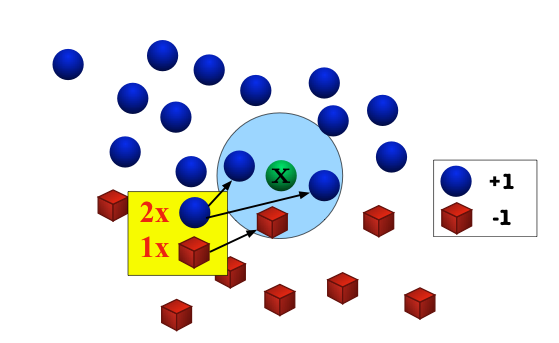The k-Nearest Neighbors Algorithm¶
Assumption: Nearby inputs have similar outputs.
Hypothesis: Given a test input x, output the most common label among its k most-similar training inputs.
- 1-nearest neighbors is simpler: just output the label of the most-similar training input.
k-Nearest Neighbors Illustration¶

k-NN Formally¶
- Start with training set (x_1, y_1), \ldots, (x_n, y_n)
- Given input x_{\text{test}}
- Compute d_i = \operatorname{dist}(x_{\text{test}}, x_i) for all i \in \{1, \ldots, n\}
- Compute S, where S \subset \{1,\ldots, n\}, |S| = k, and i \in S, \; j \notin S \; \rightarrow \; d_i \le d_j
- Output the most common label h(x_{\text{test}}) = \arg \max_{y \in \mathcal{Y}} \; \left|\left\{ i \in S \middle| y_i = y \right\} \right|
What should we do in case of a tie?
- Choose at random/arbitrarily
- Fall back to k - 1; go up to k+1
k-NN For Regression¶
- Start with training set (x_1, y_1), \ldots, (x_n, y_n)
- Given input x_{\text{test}}
- Compute d_i = \operatorname{dist}(x_{\text{test}}, x_i) for all i \in \{1, \ldots, n\}
- Compute S, where S \subset \{1,\ldots, n\}, |S| = k, and i \in S, \; j \notin S \; \rightarrow \; d_i \le d_j
- Output the average of the labels h(x_{\text{test}}) = \frac{1}{k} \sum_{i \in S} y_i.
What distance function should we use?¶
Most common distance: the Euclidean distance \operatorname{dist}(u,v) = \| u - v \|_2 = \sqrt{ \sum_{i=1}^d (u_i - v_i)^2 }
Also popular: the taxicab norm (a.k.a. Manhattan norm) \operatorname{dist}(u,v) = \| u - v \|_1 = \sum_{i=1}^d |u_i - v_i|
The Minkowski distance (a.k.a. \ell_p space)¶
For parameter p \ge 1
\operatorname{dist}(u,v) = \| u - v \|_p = \left( \sum_{i=1}^d |u_i - v_i|^p \right)^{1/p}Generalizes many other norms, including the popular \ell_2 (Euclidean), \ell_1 (taxicab), and \ell_{\infty} (max norm).
- Many other norms are used in practice, including learned norms.
- Which norm to use will depend on your task.
%matplotlib notebook
knn_demo_1()
%matplotlib notebook
knn_demo_2()
Click on the images above, to cycle through the test images.
knn_demo_3()
interactive(children=(IntSlider(value=1, description='k', max=19, min=1, step=2), Output()), _dom_classes=('wi…
Bayes Optimal Classifier¶
The Bayes Optimal Classifier is the hypothesis
h_{\operatorname{opt}}(x) = \arg \max_{y \in \mathcal{Y}} \; \mathcal{P}(y | x) = \arg \max_{y \in \mathcal{Y}} \; \mathcal{P}(x, y).- It picks the label that is most likely in the source distribution \mathcal{P}.
- This is the "best" hypothesis possible for the task, and its loss/error measures the best you could do.
Bayes Optimal Classifier: A Silly Example¶
- Suppose you are playing your favorite RPG and you get attacked by a wolf-like creature.
- You want to predict whether the creature is a wolf or a werewolf.
- Wolves occur with probability 50%, and werewolves 50%.
- You observe the amount of damage the creature did, and you know how much damage wolves and werewolves do.
- A wolf deals damage equal to a roll on a six-sided dice plus one.

- A werewolf deals damage equal to the sum of the rolls on two four-sided dice.


- A wolf deals damage equal to a roll on a six-sided dice plus one.
Bayes Optimal Classifier: Conditional Probability¶
Conditional probability of damage x conditioned on label y.
| Damage | Wolf (1d6+1) | Werewolf (2d4) |
|---|---|---|
| 2 | 1/6 | 1/16 |
| 3 | 1/6 | 1/8 |
| 4 | 1/6 | 3/16 |
| 5 | 1/6 | 1/4 |
| 6 | 1/6 | 3/16 |
| 7 | 1/6 | 1/8 |
| 8 | 0 | 1/16 |
Bayes Optimal Classifier: Joint Probability¶
Joint density: \mathcal{P}(x,y) = \mathcal{P}(x | y) \mathcal{P}(y) = \mathcal{P}(x | y) \cdot \frac{1}{2}
| Damage | Wolf (1d6+1) | Werewolf (2d4) |
|---|---|---|
| 2 | 1/12 | 1/32 |
| 3 | 1/12 | 1/16 |
| 4 | 1/12 | 3/32 |
| 5 | 1/12 | 1/8 |
| 6 | 1/12 | 3/32 |
| 7 | 1/12 | 1/16 |
| 8 | 0 | 1/32 |
Bayes Optimal Classifier: The Hypothesis¶
Always guess the label with the highest probability.
| Damage | Wolf (1d6+1) | Werewolf (2d4) | Bayes Optimal Classifier Prediction |
|---|---|---|---|
| 2 | 1/12 | 1/32 | Wolf |
| 3 | 1/12 | 1/16 | Wolf |
| 4 | 1/12 | 3/32 | Werewolf |
| 5 | 1/12 | 1/8 | Werewolf |
| 6 | 1/12 | 3/32 | Werewolf |
| 7 | 1/12 | 1/16 | Wolf |
| 8 | 0 | 1/32 | Werewolf |
Does this being "optimal" mean we get it right all the time?
Bayes Optimal Classifier: What's the Error Rate?¶
We get it wrong when the true label disagrees with our prediction.
| Damage | Wolf (1d6+1) | Werewolf (2d4) | Bayes Optimal Classifier Prediction |
|---|---|---|---|
| 2 | 1/12 | 1/32 | Wolf |
| 3 | 1/12 | 1/16 | Wolf |
| 4 | 1/12 | 3/32 | Werewolf |
| 5 | 1/12 | 1/8 | Werewolf |
| 6 | 1/12 | 3/32 | Werewolf |
| 7 | 1/12 | 1/16 | Wolf |
| 8 | 0 | 1/32 | Werewolf |
\operatorname{error} = \frac{1}{32} + \frac{1}{16} + \frac{1}{12} + \frac{1}{12} + \frac{1}{12} + \frac{1}{16} + 0 = \frac{13}{32} \approx 41\%.
Bayes Optimal Classifier: Take-Away¶
- We care about the Bayes Optimal Classifier because it gives us a "best-case" baseline against which we can compare our hypothesis' performance.
- Although only in theory: in practice we don't know \mathcal{P}
- Expected Error of Bayes Optimal Classifier is lowest possible.
- Is the loss of the Bayes Optimal Classifier always the lowest possible?
Best Constant Predictor¶
Another important baseline is the Best Constant Predictor.
h(x) = \arg \max_{y \in \mathcal{Y}} \; \mathcal{P}(y).- Just guesses the label that occurs the most often.
- This predicts completely independently of x.
- Important for debugging: You should always be able to show that your classifier performs significantly better on the test set than the Best Constant Predictor.
How does k-NN compare to the Bayes Optimal Classifier?¶
We can bound the error of 1-NN relative to the Bayes Optimal Classifier.
- Here we'll follow the original proof in Cover and Hart (1967).
Lemma: Convergence of the Nearest Neighbor¶
Suppose that (\mathcal{X}, \operatorname{dist}) is a separable metric space.
- A metric space is separable if there is countable subset of \mathcal{X} that is dense in the space, i.e. a sequence that comes arbitrarily close to every point in the space.
- In particular, \mathbb{R}^d is separable.
Let x_{\text{test}} and x_1, x_2, \ldots be independent identically distributed random variables over \mathcal{X}. Then almost surely (i.e. with probability 1)
\lim_{n \rightarrow \infty} \; \arg \min_{x \in \{x_1, \ldots, x_n\}} \operatorname{dist}(x, x_{\text{test}}) = x_{\text{test}}.Proof Outline: Case 1¶
Consider the case where any ball of radius r centered around x_{\text{test}} has positive probability.
Then, no matter now close the current nearest neighbor is to x_{\text{test}}, every time we draw a fresh sample x_i from the source distribution, with some probability it will be closer than the nearest neighbor currently in the distribution.
This implies that the distance diminishes to 0 with probability 1.
Proof Outline: Case 2¶
Consider the case where there is some ball of radius r centered around x_{\text{test}} that has probability zero in the source distribution.
But this must happen with zero probability in the random selection of x_{\text{test}}.
Why? Let Z be the set of all points in \mathcal{X} that have the property that they are the center of some ball with zero probability. Then because \mathcal{X} is separable, we can cover Z with the union of a countable number of balls with zero probability. So Z itself must have zero probability.
You defintely don't need to know this topology stuff for CS4/5780, but I think it's good to mention it so you have some intuition about when NN might fail on exotic spaces.
Bounding the Error of 1-NN¶
Let x_{\text{test}} denote a test point randomly drawn from \mathcal{P}. Let \hat x_n (also a random variable) denote the nearest neighbor to x_{\text{test}} in an independent training dataset of size n.
The expected error of the 1-NN classifier is \operatorname{error}_{\text{1-NN}} = \mathbf{E}\left[ \sum_{y \in \mathcal{Y}} \mathcal{P}(y | \hat x_n) \left(1 - \mathcal{P}(y | x_{\text{test}})\right) \right]. This is the sum over all labels y of the probability that the prediction will be y but the true label will not be y.
Bounding the Error of 1-NN in the limit¶
Taking the limit as n approaches infinity, the expected error is \begin{align*} \lim_{n \rightarrow \infty} \; \operatorname{error}_{\text{1-NN}} &= \lim_{n \rightarrow \infty} \; \mathbf{E}\left[ \sum_{y \in \mathcal{Y}} \mathcal{P}(y | \hat x_n) \left(1 - \mathcal{P}(y | x_{\text{test}})\right) \right] \\&= \mathbf{E}\left[ \sum_{y \in \mathcal{Y}} \mathcal{P}(y | x_{\text{test}})) \left(1 - \mathcal{P}(y | x_{\text{test}})\right) \right] \end{align*}
Comparing to the Bayes Optimal Classifier¶
Let \hat y denote the prediction of the Bayes Optimal Classifier on x_{\text{test}}. \begin{align*} \lim{n \rightarrow \infty} \; \operatorname{error}{\text{1-NN}} &= \mathbf{E}\left[ \mathcal{P}(\hat y | x{\text{test}}) \left(1 - \mathcal{P}(\hat y | x{\text{test}})\right) \right] \&\hspace{2em}+ \mathbf{E}\left[ \sum{y \ne \hat y} \mathcal{P}(y | x{\text{test}})) \left(1 - \mathcal{P}(y | x{\text{test}})\right) \right] \&\le \mathbf{E}\left[ 1 \cdot \left( 1 - \mathcal{P}(\hat y | x{\text{test}}) \right) \right] + \mathbf{E}\left[ \sum{y \ne \hat y} 1 \cdot \mathcal{P}(y | x{\text{test}})) \right] \&=
2 \mathbf{E}\left[ 1 - \mathcal{P}(\hat y | x_{\text{test}})\right]
=
2 \operatorname{error}_{\text{Bayes}}.
\end{align*}
Conclusion: 1-NN is no more than a factor-of-2 worse¶
\lim_{n \rightarrow \infty} \; \operatorname{error}_{\text{1-NN}} \le 2 \operatorname{error}_{\text{Bayes}}....in the limit...and results in-the-limit can be suspicious because they don't tell us how fast we converge¶

k-NN is limited by The Curse of Dimensionality!¶
k-NN works by reasoning about how close together points are.
In high dimensional space, points drawn from a distribution tend not to be close together.
- Need to draw a very large number of points before you'll get two that are particularly close to each other.
First, let's look at some random points and a line in the unit square.
fig = plt.figure(); X=np.random.rand(50,2);
plot(X[:,0],X[:,1],'b.'); plot([0,1],[0.5,0.5],'r-'); axis('square'); axis((0,1,0,1));
Consider what happens when we move to three dimensions. The points move further away from each other but stay equally close to the red hyperplane.
(fig,animate) = curse_demo_1()
ani = FuncAnimation(fig, animate,arange(1,100,1),interval=10);
curse_demo_2()
curse_demo_3()
Curse of Dimensionality¶
The pairwise distance between two points in a unit cube (or sphere, or from a unit Gaussian) increases with dimension.
- Classifiers that use pairwise distances can have no points nearby a given test point.
- Which point is the nearest can depend on measurement noise.
In comparison, the distance to a hyperplane does not increase.
Low-Dimensional Structure to the Rescue¶
If the data lies in a low-dimensional submanifold, then we can still use low-dimensional methods even in higher dimensions.
- E.g. human faces

Reminders¶
Please finish the prelim exam (placement quiz)!
First homework is out tonight!
- Work in groups of up to two (2)!